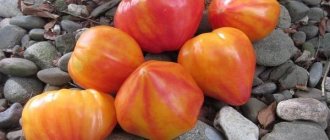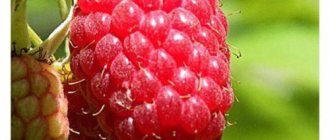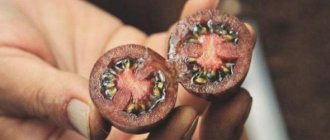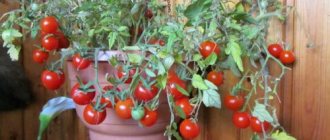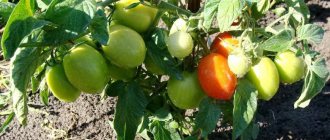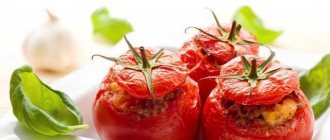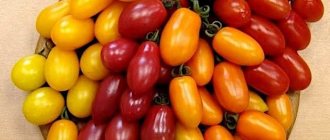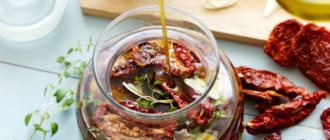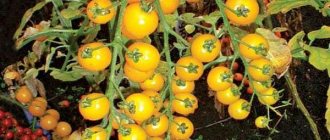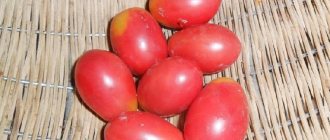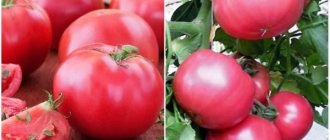| Ripening period: | early ripening |
| Shape, weight of fruits: | ovoid, 30 g |
| Bush type: | indeterminate |
| Growing regions: | all Russia |
| Productivity: | 13.8 kg per 1 sq. m |
For many gardeners, tomato yield is not the last criterion that influences which variety or hybrid they choose. Today, high-yielding varieties of tomatoes have been developed and are being developed for growing at home. In 2019, a new hybrid with cherry fruits, the Vera tomato, was added to the State Register. Gardeners who would like to plant it will be interested in information about the characteristics and agricultural technology of the plant.
Characteristics and description of the variety
The hybrid Cherry Vera is recommended to be grown in private plots not in open beds, but in greenhouses or hotbeds. The variety is early ripening (90-95 days pass from germination to the first tomatoes).
Description of the variety:
- indeterminate bush (grows up to 2 m in height);
- leaf dark green, medium size;
- intermediate inflorescence, up to 20 ovaries are formed on one;
- The 1st fruit cluster is formed after the 9th leaf;
- stalk with articulation;
- tomatoes are ovoid, slightly ribbed, with dense pulp, smooth skin;
- unripe tomatoes are light green, ripe ones are red;
- number of seed chambers – 2;
- the taste is good.
The yield of the early ripening hybrid Cherry Vera with a small size and weight of fruits - only 30 g - is 13.8 kg per square meter. m.
Tomatoes are universal in use; they can be used for fresh eating and for a variety of canning. It is convenient to marinate them in jars of different sizes.
You can see what Cherry Vera tomato bushes look like in the photos below.
Characteristics of the variety
Cherry Vera F1 is a tomato variety with small fruits. Their weight ranges from 15-40 grams. All Cherry tomatoes compare favorably with their relatives with their rich, sweet taste. Breeders have developed many species of this variety. In the process of creating new species, disadvantages were removed and advantages were introduced.
So, over time, these small cherry tomatoes acquired a lot of advantages. The smallest varieties can be grown even at home on a windowsill, so there will be fresh tomatoes on the table all year round.
Description of the plant
Cherry tomatoes F1 are a variety of small-fruited tomatoes intended for growing in greenhouses (you can find out what other varieties of cherry tomatoes are suitable for growing in a greenhouse here). The variety is tall (indeterminate), early ripening, with a powerful stem. It can reach more than 2 meters in height.
Main characteristics of the hybrid:
- weight of one fruit – up to 30 g;
- the pulp is dense, sweet, aromatic;
- seed chambers – two;
- obovate shape with a small pointed nose.
By the time the tomato is fully ripe, the nose smooths out a little.
What regions is it suitable for?
In central Russia, Cherry Vera tomatoes are grown in greenhouses. Since the plant is indeterminate, the stems require support.
It is most convenient to use garters that are attached to the ceiling of the greenhouse and extend along the length almost to the ground. As the plant grows, it is necessary to carefully wrap the garter around the stem so as not to damage it.
In the southern regions, growing the Cherry Vera hybrid in open ground is allowed (we talked about the best low-growing and other varieties of cherry tomatoes for open ground in a separate article). In this case, trellises are used to tie up the stems.
Precocity
On average, from germination to full ripening it takes from 90 to 100 days. Another advantage of the hybrid is the possibility of ripening. If the fruits on one cluster are unevenly ripened, you can cut it off entirely and set it aside to ripen.
Productivity
This setting is affected by several conditions. If you follow all the rules of cultivation and care, the plant will reward you with a generous harvest - from 15 to 18 kilograms per square meter.
In order for the hybrid to meet the gardener’s expectations, the Cherry Vera tomato should be provided with the following conditions:
- cultivation in closed ground (greenhouse, hotbed);
- timely ventilation and watering;
- planting seedlings up to 5 plants per 1 m2 with mandatory formation into one stem.
Sowing and growing seedlings
Tomato Cherry Vera F1 is grown through seedlings. Since they are planted in greenhouses, the seeds can be sown quite early - in February.
It is recommended to plant hybrid seeds in separate pots. It is enough for them to have a volume of about 0.3 liters.
Joint cultivation in boxes is not recommended; it is better to plant each plant separately, so as not to replant it later and not injure the roots.
Growing conditions: temperature of at least 25˚С at the first stage, until the sprouts emerge from the ground, and at least 20˚С the rest of the time, humidity 70%. Lighting - lasting at least 10-12 hours.
Growing should be carried out in the brightest place in the room. Traditionally, pots are placed on or near a windowsill. If there is not enough light, you need to use backlighting from fluorescent lamps. In a poorly lit place, plants will quickly stretch out and become pale. Such seedlings take a long time to take root and often get sick.
Water cherry tomatoes only with warm, settled water, in a small volume, but so that it soaks the entire substrate completely. The frequency of watering should be moderate so that the soil is not wet.
Tomato seedlings should be fed no more than once every 2 weeks. You can apply both mineral fertilizers and organic matter, but it is easier to use ready-made complex fertilizers. What proportion to use is indicated in the instructions for the fertilizer.
Hardening is not carried out for greenhouse tomatoes. But if they are grown for open beds, then they need to be hardened off within the last 7-10 days.
The plants should be approximately 1.5 months old at the time of transplantation.
Calorie content and composition of cherry tomatoes
The calorie content of cherry tomatoes is 15 kcal per 100 grams. For other varieties of tomatoes (medium and large), this figure is close to 24 kcal per 100 grams. So cherry, despite its sweet taste, has a low calorie content even in comparison with its close “relatives”. The ratio of BJU (per 100 g) is as follows:
- proteins – 1g (11%);
- fats – 2 g (47%);
- carbohydrates – 4 g (42%).
The general ratio of BJU is 1: 2: 4. For juicy tomatoes, 92 g out of 100 is water.
Cherry tomatoes are not as productive as large-fruited varieties, but nutritionists note their greater nutritional value. Large-fruited tomatoes contain 4% dry matter, and cherry tomatoes contain as much as 12%. Sweet pastes, juices, and sauces made from cherry tomatoes are thick and tasty. They are enjoyed with pleasure in winter. The composition of tomato berries is rich and varied. The fruits contain:
- vitamins B, C, beta-carotene (provitamin A), E, H, K, PP;
- a complex of minerals, among which cobalt, potassium, and copper predominate;
- nonessential and essential amino acids are the building blocks of proteins;
- mono- and disaccharides: glucose, sucrose, fructose;
- polysugars: starch, dextrins.
Despite the rich composition of vitamins and minerals, the healthy berry is not able to meet the body's needs for all the necessary components, so it is important to diversify the human diet. Include other vegetables rather than limiting yourself to your favorite, sweet cherry tomatoes
Planting in the ground and caring for tomatoes
Cherry Vera tomato is placed in beds with a density of 5 plants per 1 square meter. m, place them in grooves or holes. After planting is completed, the tomatoes are watered and the area of the beds is covered with peat chips, sawdust or hay. Without mulch, you will have to loosen the soil after each irrigation, and it will also dry out faster.
Since these tomatoes are tall, they must be tied to a support or trellis. You should take care of this in advance and place pegs on the beds. When the plants grow, they are tied to a support.
Tomatoes need to be formed into 2-3 stems. This is necessary so that enough flowers are formed on the plants to obtain the harvest promised by the seed manufacturer.
They are formed according to the following scheme: in addition to the main stem, leave 1 or 2 of the lowest stepsons, and remove the rest. Next, you need to pick off the lower leaves when they have fulfilled their functions and turn yellow. This will allow air to pass more freely over the ground and reduce the likelihood of illness.
Cherry Vera tomatoes are watered throughout the growing season, once every 2-3 days. They require especially a lot of water at the initial stage of growth and during mass ripening of fruits.
On hot days you need to water more often, on cloudy days - less often. Towards the end of the growing season, watering is gradually reduced, and then stopped altogether.
After each irrigation, the soil must be loosened if mulch is not laid on the beds.
Tomatoes need to be fed at least 3 times per season: before flowering begins, then with an interval of 2 weeks. Fertilizers are standard for feeding this crop: saltpeter, urea, superphosphate, potassium salt, potassium monophosphate, etc. Solutions must be diluted according to the instructions.
Folk remedies for feeding: infusion of manure (1 to 10) and ash solution (1 tbsp. per 10 l).
The first harvest of super-early tomatoes can begin to be harvested approximately 3 months after germination, and until all the fruits are completely ripened.
Tomatoes store well; due to their small size, they can be well packaged and transported.
More details about growing this hybrid can be seen in the video.
Advantages and disadvantages
Cherry Vera tomatoes have many advantages: they have high yields, excellent taste and marketability, fruits of uniform size, and ripen early. In addition to these qualities, the hybrid is resistant to fungal infections and is easy to care for.
All this makes the tomato suitable for growing by vegetable growers who have little experience in home gardening.
In reviews of the hybrid, gardeners highlight the high cost of planting material and the presence of only 5 seeds per package.
Tomato 'Idil cocktail red'
In my opinion, idil is close to ideal. And this is truly an impeccable cocktail variety.
Tomato 'Idil cocktail red'
Indeterminate, 1.5-2 m high. Mid-season (100-110 days). The fruits are bright red, round, sour, weighing 20-30 g, collected 20 pieces in a cluster.
Excellent cherry hybrids that can be prepared dried for gourmet dishes.
Tomato 'Kish-Mish red F1'. Tomato 'Kish-Mish yellow F1'
Indeterminate, 1.6-2 m high. Medium early. The fruits are bright red and bright yellow, round, sweet, weighing up to 20 g, collected 20-50 pieces in a cluster.
Diseases and pests of the hybrid
Hybrid Cherry Vera F1 is resistant to verticillium, root-knot nematodes, and fusarium. Despite this, it is recommended to carry out preventive treatments with fungicides against these diseases.
To combat pests that can also settle on tomato plants, folk remedies or chemical insecticides are used.
To be successful, the fight against diseases and pests must begin when the very first signs of damage appear.
Cherry Vera tomatoes, video
If you grew Vera cherry tomatoes, please write whether you liked them or not. What was the yield and taste of the fruits like under your climatic conditions? How do you rate the disease resistance of this hybrid? Briefly describe the advantages and disadvantages of this tomato in your opinion. If possible, attach to your review a photo of the entire bush or individual fruits you grew. Thank you!
Your reviews of the Cherry Vera tomato and additions to the description will help many gardeners evaluate this hybrid more objectively and decide whether it is worth planting or not.
Cherry Vera F1 from agro amazes with huge clusters of up to 30 fruits. Tomatoes store well, do not lose their presentation during transportation, and retain their taste and aroma for a long time.
